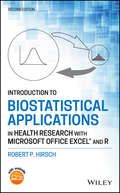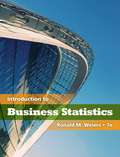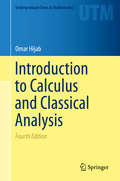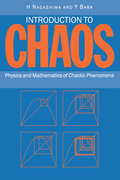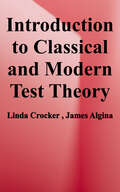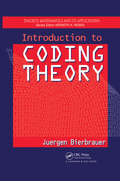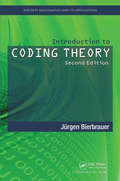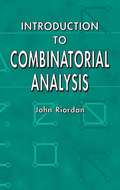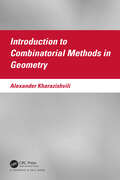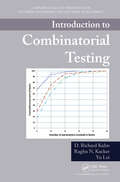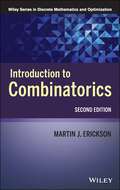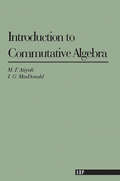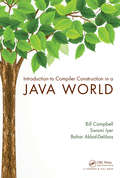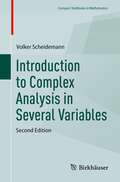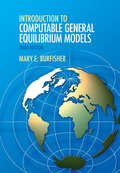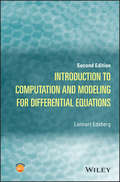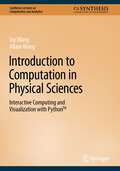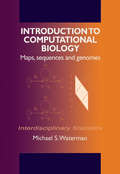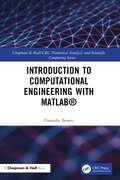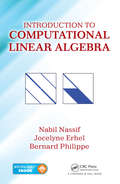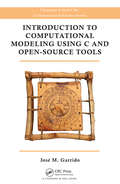- Table View
- List View
Introduction to Biostatistical Applications in Health Research with Microsoft Office Excel and R
by Robert P. HirschThe second edition of Introduction to Biostatistical Applications in Health Research delivers a thorough examination of the basic techniques and most commonly used statistical methods in health research. Retaining much of what was popular with the well-received first edition, the thoroughly revised second edition includes a new chapter on testing assumptions and how to evaluate whether those assumptions are satisfied and what to do if they are not. The newest edition contains brand-new code examples for using the popular computer language R to perform the statistical analyses described in the chapters within. You’ll learn how to use Excel to generate datasets for R, which can then be used to conduct statistical calculations on your data. The book also includes a companion website with a new version of BAHR add-in programs for Excel. This new version contains new programs for nonparametric analyses, Student-Newman-Keuls tests, and stratified analyses. Readers will also benefit from coverage of topics like: Extensive discussions of basic and foundational concepts in statistical methods, including Bayes’ Theorem, populations, and samples A treatment of univariable analysis, covering topics like continuous dependent variables and ordinal dependent variables An examination of bivariable analysis, including regression analysis and correlation analysis An analysis of multivariate calculations in statistics and how testing assumptions, like assuming Gaussian distributions or equal variances, affect statistical outcomes Perfect for health researchers of all kinds, Introduction to Biostatistical Applications in Health Research also belongs on the bookshelves of anyone who wishes to better understand health research literature. Even those without a great deal of mathematical background will benefit greatly from this text.
Introduction to Business Statistics (Seventh Edition)
by Ronald M. WeiersThis proven, popular text cuts through the jargon to help you understand fundamental statistical concepts and why they are important to you, your world, and your career. The text's outstanding illustrations, friendly language, non-technical terminology, and current, real-world examples will capture your interest and prepare you for success right from the start.
Introduction to Calculus and Classical Analysis
by Omar HijabThis text is intended for an honors calculus course or for an introduction to analysis. Involving rigorous analysis, computational dexterity, and a breadth of applications, it is ideal for undergraduate majors. This third edition includes corrections as well as some additional material. Some features of the text include: The text is completely self-contained and starts with the real number axioms; The integral is defined as the area under the graph, while the area is defined for every subset of the plane; There is a heavy emphasis on computational problems, from the high-school quadratic formula to the formula for the derivative of the zeta function at zero; There are applications from many parts of analysis, e. g. , convexity, the Cantor set, continued fractions, the AGM, the theta and zeta functions, transcendental numbers, the Bessel and gamma functions, and many more; Traditionally transcendentally presented material, such as infinite products, the Bernoulli series, and the zeta functional equation, is developed over the reals; and There are 385 problems with all the solutions at the back of the text.
Introduction to Chaos: Physics and Mathematics of Chaotic Phenomena
by H NagashimaThis book focuses on explaining the fundamentals of the physics and mathematics of chaotic phenomena by studying examples from one-dimensional maps and simple differential equations. It is helpful for postgraduate students and researchers in mathematics, physics and other areas of science.
Introduction to Classical and Modern Test Theory
by Linda Crocker James AlginaStudents of modern test theory must acquire a base of knowledge about classical psychometrics, but they must also be able to integrate new ideas into that framework of knowledge. <p><p>This text was written to help the reader attain these ends. The reader who hopes to find only a series of “cookbook” steps on how to carry out any specific process, uncluttered by technical discussion or statistical symbols, will be disappointed. <p><P>We recognize that “best” or “most recommended” procedures for any aspect of test development may change as new ideas and empirical findings are published. Thus it seems desirable for the students of test theory to acquire some practice in reading material that contains technical terms and symbols similar to those which will be encountered as they graduate from a textbook and begin to read the professional literature independently.
Introduction to Coalgebra: Towards Mathematics of States and Observation
by Bart JacobsThe area of coalgebra has emerged within theoretical computer science with a unifying claim: to be the mathematics of computational dynamics. It combines ideas from the theory of dynamical systems and from the theory of state-based computation. Although still in its infancy, it is an active area of research that generates wide interest. Written by one of the founders of the field, this book acts as the first mature and accessible introduction to coalgebra. It provides clear mathematical explanations, with many examples and exercises involving deterministic and non-deterministic automata, transition systems, streams, Markov chains and weighted automata. The theory is expressed in the language of category theory, which provides the right abstraction to make the similarity and duality between algebra and coalgebra explicit, and which the reader is introduced to in a hands-on manner. The book will be useful to mathematicians and (theoretical) computer scientists and will also be of interest to mathematical physicists, biologists and economists.
Introduction to Coding Theory (Discrete Mathematics and Its Applications #5)
by Jurgen BierbrauerAlthough its roots lie in information theory, the applications of coding theory now extend to statistics, cryptography, and many areas of pure mathematics, as well as pervading large parts of theoretical computer science, from universal hashing to numerical integration.Introduction to Coding Theory introduces the theory of error-correcting codes in a thorough but gentle presentation. Part I begins with basic concepts, then builds from binary linear codes and Reed-Solomon codes to universal hashing, asymptotic results, and 3-dimensional codes. Part II emphasizes cyclic codes, applications, and the geometric desciption of codes. The author takes a unique, more natural approach to cyclic codes that is not couched in ring theory but by virtue of its simplicity, leads to far-reaching generalizations. Throughout the book, his discussions are packed with applications that include, but reach well beyond, data transmission, with each one introduced as soon as the codes are developed.Although designed as an undergraduate text with myriad exercises, lists of key topics, and chapter summaries, Introduction to Coding Theory explores enough advanced topics to hold equal value as a graduate text and professional reference. Mastering the contents of this book brings a complete understanding of the theory of cyclic codes, including their various applications and the Euclidean algorithm decoding of BCH-codes, and carries readers to the level of the most recent research.
Introduction to Coding Theory (Discrete Mathematics and Its Applications)
by Jurgen BierbrauerThis book is designed to be usable as a textbook for an undergraduate course or for an advanced graduate course in coding theory as well as a reference for researchers in discrete mathematics, engineering and theoretical computer science. This second edition has three parts: an elementary introduction to coding, theory and applications of codes, and algebraic curves. The latter part presents a brief introduction to the theory of algebraic curves and its most important applications to coding theory.
Introduction to Combinatorial Analysis (Dover Books on Mathematics #4668)
by John RiordanThis introduction to combinatorial analysis defines the subject as "the number of ways there are of doing some well-defined operation." Chapter 1 surveys that part of the theory of permutations and combinations that finds a place in books on elementary algebra, which leads to the extended treatment of generation functions in Chapter 2, where an important result is the introduction of a set of multivariable polynomials.Chapter 3 contains an extended treatment of the principle of inclusion and exclusion which is indispensable to the enumeration of permutations with restricted position given in Chapters 7 and 8. Chapter 4 examines the enumeration of permutations in cyclic representation and Chapter 5 surveys the theory of distributions. Chapter 6 considers partitions, compositions, and the enumeration of trees and linear graphs.Each chapter includes a lengthy problem section, intended to develop the text and to aid the reader. These problems assume a certain amount of mathematical maturity. Equations, theorems, sections, examples, and problems are numbered consecutively in each chapter and are referred to by these numbers in other chapters.
Introduction to Combinatorial Designs (Discrete Mathematics and Its Applications)
by W.D. WallisCombinatorial theory is one of the fastest growing areas of modern mathematics. Focusing on a major part of this subject, Introduction to Combinatorial Designs, Second Edition provides a solid foundation in the classical areas of design theory as well as in more contemporary designs based on applications in a variety of fields.After an o
Introduction to Combinatorial Methods in Geometry
by Alexander KharazishviliThis book offers an introduction to some combinatorial (also, set-theoretical) approaches and methods in geometry of the Euclidean space Rm. The topics discussed in the manuscript are due to the field of combinatorial and convex geometry.The author’s primary intention is to discuss those themes of Euclidean geometry which might be of interest to a sufficiently wide audience of potential readers. Accordingly, the material is explained in a simple and elementary form completely accessible to the college and university students. At the same time, the author reveals profound interactions between various facts and statements from different areas of mathematics: the theory of convex sets, finite and infinite combinatorics, graph theory, measure theory, classical number theory, etc.All chapters (and also the five Appendices) end with a number of exercises. These provide the reader with some additional information about topics considered in the main text of this book. Naturally, the exercises vary in their difficulty. Among them there are almost trivial, standard, nontrivial, rather difficult, and difficult. As a rule, more difficult exercises are marked by asterisks and are provided with necessary hints.The material presented is based on the lecture course given by the author. The choice of material serves to demonstrate the unity of mathematics and variety of unexpected interrelations between distinct mathematical branches.
Introduction to Combinatorial Testing (Chapman & Hall/CRC Innovations in Software Engineering and Software Development Series)
by Yu Lei D. Richard Kuhn Raghu N. KackerCombinatorial testing of software analyzes interactions among variables using a very small number of tests. This advanced approach has demonstrated success in providing strong, low-cost testing in real-world situations. Introduction to Combinatorial Testing presents a complete self-contained tutorial on advanced combinatorial testing methods for re
Introduction to Combinatorics
by Martin J. EricksonPraise for the First Edition "This excellent text should prove a useful accoutrement for any developing mathematics program . . . it's short, it's sweet, it's beautifully written." --The Mathematical Intelligencer"Erickson has prepared an exemplary work . . . strongly recommended for inclusion in undergraduate-level library collections." --ChoiceFeaturing a modern approach, Introduction to Combinatorics, Second Edition illustrates the applicability of combinatorial methods and discusses topics that are not typically addressed in literature, such as Alcuin's sequence, Rook paths, and Leech's lattice. The book also presents fundamental results, discusses interconnection and problem-solving techniques, and collects and disseminates open problems that raise questions and observations.Many important combinatorial methods are revisited and repeated several times throughout the book in exercises, examples, theorems, and proofs alike, allowing readers to build confidence and reinforce their understanding of complex material. In addition, the author successfully guides readers step-by-step through three major achievements of combinatorics: Van der Waerden's theorem on arithmetic progressions, Pólya's graph enumeration formula, and Leech's 24-dimensional lattice. Along with updated tables and references that reflect recent advances in various areas, such as error-correcting codes and combinatorial designs, the Second Edition also features:Many new exercises to help readers understand and apply combinatorial techniques and ideasA deeper, investigative study of combinatorics through exercises requiring the use of computer programsOver fifty new examples, ranging in level from routine to advanced, that illustrate important combinatorial conceptsBasic principles and theories in combinatorics as well as new and innovative results in the fieldIntroduction to Combinatorics, Second Edition is an ideal textbook for a one- or two-semester sequence in combinatorics, graph theory, and discrete mathematics at the upper-undergraduate level. The book is also an excellent reference for anyone interested in the various applications of elementary combinatorics.
Introduction to Commutative Algebra
by M. F. Atiyah I. G. MacdonaldThis book grew out of a course of lectures given to third year undergraduates at Oxford University and it has the modest aim of producing a rapid introduction to the subject. It is designed to be read by students who have had a first elementary course in general algebra. On the other hand, it is not intended as a substitute for the more voluminous tracts such as Zariski-Samuel or Bourbaki. We have concentrated on certain central topics, and large areas, such as field theory, are not touched. In content we cover rather more ground than Northcott and our treatment is substantially different in that, following the modern trend, we put more emphasis on modules and localization.
Introduction to Compact Riemann Surfaces and Dessins d'Enfants
by Ernesto Girondo Gabino González-DiezFew books on the subject of Riemann surfaces cover the relatively modern theory of dessins d'enfants (children's drawings), which was launched by Grothendieck in the 1980s and is now an active field of research. In this 2011 book, the authors begin with an elementary account of the theory of compact Riemann surfaces viewed as algebraic curves and as quotients of the hyperbolic plane by the action of Fuchsian groups of finite type. They then use this knowledge to introduce the reader to the theory of dessins d'enfants and its connection with algebraic curves defined over number fields. A large number of worked examples are provided to aid understanding, so no experience beyond the undergraduate level is required. Readers without any previous knowledge of the field of dessins d'enfants are taken rapidly to the forefront of current research.
Introduction to Compiler Construction in a Java World
by Bill Campbell Swami Iyer Bahar Akbal-DelibasImmersing students in Java and the JVM, this text enables a deep understanding of the Java programming language and its implementation. It focuses on design, organization, and testing, helping students learn good software engineering skills and become better programmers. By working with and extending a real, functional compiler, students develop a hands-on appreciation of how compilers work, how to write compilers, and how the Java language behaves. Fully documented Java code for the compiler is accessible on a supplementary website.
Introduction to Complex Analysis in Several Variables (Compact Textbooks in Mathematics)
by Volker ScheidemannThis book provides a comprehensive introduction to complex analysis in several variables. One major focus of the book is extension phenomena alien to the one-dimensional theory (Hartog's Kugelsatz, theorem of Cartan-Thullen, Bochner's theorem). The book primarily aims at students starting to work in the field of complex analysis in several variables and teachers who want to prepare a university lecture. Therefore, the book contains more than 50 examples and more than 100 supporting exercises.
Introduction to Computable General Equilibrium Models
by Mary E. BurfisherComputable general equilibrium (CGE) models play an important role in supporting public-policy making on such issues as trade, climate change and taxation. This significantly revised volume, keeping pace with the next-generation standard CGE model, is the only undergraduate-level introduction of its kind. The volume utilizes a graphical approach to explain the economic theory underlying a CGE model, and provides results from simple, small-scale CGE models to illustrate the links between theory and model outcomes. Its eleven hands-on exercises introduce modelling techniques that are applied to real-world economic problems. Students learn how to integrate their separate fields of economic study into a comprehensive, general equilibrium perspective as they develop their skills as producers or consumers of CGE-based analysis.
Introduction to Computation and Modeling for Differential Equations
by Lennart EdsbergAn introduction to scientific computing for differential equationsIntroduction to Computation and Modeling for Differential Equations provides a unified and integrated view of numerical analysis, mathematical modeling in applications, and programming to solve differential equations, which is essential in problem-solving across many disciplines, such as engineering, physics, and economics. This book successfully introduces readers to the subject through a unique "Five-M" approach: Modeling, Mathematics, Methods, MATLAB, and Multiphysics. This approach facilitates a thorough understanding of how models are created and preprocessed mathematically with scaling, classification, and approximation, and it also illustrates how a problem is solved numerically using the appropriate mathematical methods.The book's approach of solving a problem with mathematical, numerical, and programming tools is unique and covers a wide array of topics, from mathematical modeling to implementing a working computer program. The author utilizes the principles and applications of scientific computing to solve problems involving:Ordinary differential equationsNumerical methods for Initial Value Problems (IVPs)Numerical methods for Boundary Value Problems (BVPs)Partial Differential Equations (PDEs)Numerical methods for parabolic, elliptic, and hyperbolic PDEsMathematical modeling with differential equationsNumerical solutionFinite difference and finite element methodsReal-world examples from scientific and engineering applications including mechanics, fluid dynamics, solid mechanics, chemical engineering, electromagnetic field theory, and control theory are solved through the use of MATLAB and the interactive scientific computing program Comsol Multiphysics. Numerous illustrations aid in the visualization of the solutions, and a related Web site features demonstrations, solutions to problems, MATLAB programs, and additional data.Introduction to Computation and Modeling for Differential Equations is an ideal text for courses in differential equations, ordinary differential equations, partial differential equations, and numerical methods at the upper-undergraduate and graduate levels. The book also serves as a valuable reference for researchers and practitioners in the fields of mathematics, engineering, and computer science who would like to refresh and revive their knowledge of the mathematical and numerical aspects as well as the applications of scientific computation.
Introduction to Computation in Physical Sciences: Interactive Computing And Visualization With Python (Synthesis Lectures On Computation And Analytics Series)
by Adam Wang Jay WangThis book provides a practical and comprehensive introduction to computational problem solving from the viewpoints of practitioners in both academic and industrial worlds. The authors present scientific problem-solving using computation and aim to increase computational thinking, which is the mindset and skillset required to solve scientific problems with computational methodologies via model building, simulation, data analysis, and visualization using the Python programming language. Topics and examples span fundamental areas of physical science as well as contemporary topics including quantum computing, neural networks, machine learning, global warming, and energy balance. The book features unique and innovative techniques and practices including: intentional scaffolding to help beginners learn computational problem solving; multimodal computing environments including cloud-based platforms and just-in-time computing; emphasis and connection between both numerical and symbolic computations; and extensive exercise sets carefully designed for further exploration as project assignments or self-paced study. The book is suitable for introductory level readers in physical sciences, engineering, and related STEM disciplines. Specifically, the book is appropriate for use in either a standalone course on computation and modeling and as a resource for readers interested in learning about proven techniques in interactive computing.
Introduction to Computation in Physical Sciences: Interactive Computing and Visualization with Python™ (Synthesis Lectures on Computation and Analytics)
by Adam Wang Jay WangThis book provides a practical and comprehensive introduction to computational problem solving from the viewpoints of practitioners in both academic and industrial worlds. The authors present scientific problem-solving using computation and aim to increase computational thinking, which is the mindset and skillset required to solve scientific problems with computational methodologies via model building, simulation, data analysis, and visualization using the Python programming language. Topics and examples span fundamental areas of physical science as well as contemporary topics including quantum computing, neural networks, machine learning, global warming, and energy balance. The book features unique and innovative techniques and practices including: intentional scaffolding to help beginners learn computational problem solving; multimodal computing environments including cloud-based platforms and just-in-time computing; emphasis and connection between both numerical and symbolic computations; and extensive exercise sets carefully designed for further exploration as project assignments or self-paced study. The book is suitable for introductory level readers in physical sciences, engineering, and related STEM disciplines. Specifically, the book is appropriate for use in either a standalone course on computation and modeling and as a resource for readers interested in learning about proven techniques in interactive computing.
Introduction to Computational Biology: Maps, Sequences and Genomes (Chapman & Hall/CRC Interdisciplinary Statistics)
by Michael S. WatermanBiology is in the midst of a era yielding many significant discoveries and promising many more. Unique to this era is the exponential growth in the size of information-packed databases. Inspired by a pressing need to analyze that data, Introduction to Computational Biology explores a new area of expertise that emerged from this fertile field- the combination of biological and information sciences. This introduction describes the mathematical structure of biological data, especially from sequences and chromosomes. After a brief survey of molecular biology, it studies restriction maps of DNA, rough landmark maps of the underlying sequences, and clones and clone maps. It examines problems associated with reading DNA sequences and comparing sequences to finding common patterns. The author then considers that statistics of pattern counts in sequences, RNA secondary structure, and the inference of evolutionary history of related sequences.Introduction to Computational Biology exposes the reader to the fascinating structure of biological data and explains how to treat related combinatorial and statistical problems. Written to describe mathematical formulation and development, this book helps set the stage for even more, truly interdisciplinary work in biology.
Introduction to Computational Engineering with MATLAB® (Chapman & Hall/CRC Numerical Analysis and Scientific Computing Series)
by Timothy BowerIntroduction to Computational Engineering with MATLAB® aims to teach readers how to use MATLAB programming to solve numerical engineering problems. The book focuses on computational engineering with the objective of helping engineering students improve their numerical problem-solving skills. The book cuts a middle path between undergraduate texts that simply focus on programming and advanced mathematical texts that skip over foundational concepts, feature cryptic mathematical expressions, and do not provide sufficient support for novices.Although this book covers some advanced topics, readers do not need prior computer programming experience or an advanced mathematical background. Instead, the focus is on learning how to leverage the computer and software environment to do the hard work. The problem areas discussed are related to data-driven engineering, statistics, linear algebra, and numerical methods. Some example problems discussed touch on robotics, control systems, and machine learning.Features: Demonstrates through algorithms and code segments how numeric problems are solved with only a few lines of MATLAB code Quickly teaches students the basics and gets them started programming interesting problems as soon as possible No prior computer programming experience or advanced math skills required Suitable for students at undergraduate level who have prior knowledge of college algebra, trigonometry, and are enrolled in Calculus I MATLAB script files, functions, and datasets used in examples are available for download from http://www.routledge.com/9781032221410.
Introduction to Computational Linear Algebra
by Bernard Philippe Jocelyne Erhel Nabil NassifTeach Your Students Both the Mathematics of Numerical Methods and the Art of Computer ProgrammingIntroduction to Computational Linear Algebra presents classroom-tested material on computational linear algebra and its application to numerical solutions of partial and ordinary differential equations. The book is designed for senior undergraduate stud
Introduction to Computational Modeling Using C and Open-Source Tools
by Jose M. GarridoIntroduction to Computational Modeling Using C and Open-Source Tools presents the fundamental principles of computational models from a computer science perspective. It explains how to implement these models using the C programming language. The software tools used in the book include the Gnu Scientific Library (GSL), which is a free software libra
